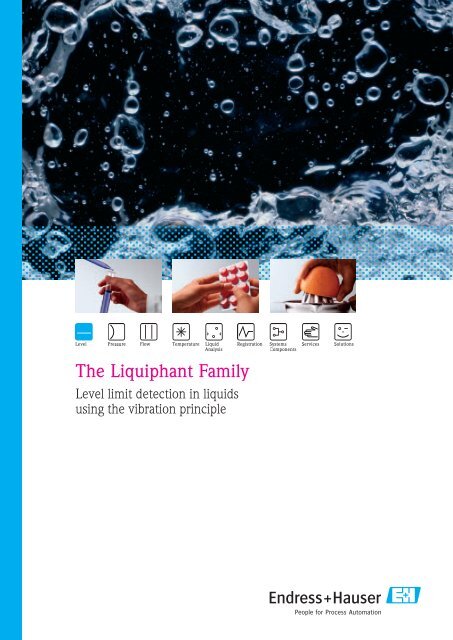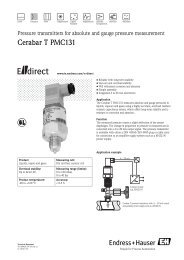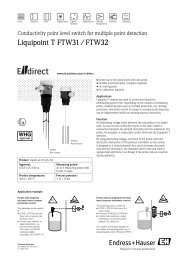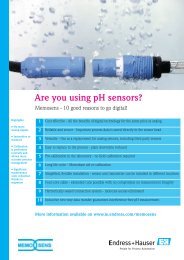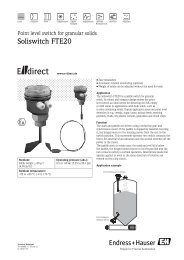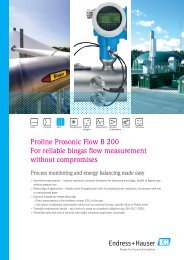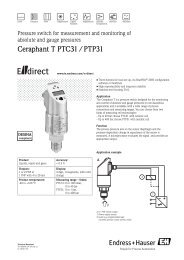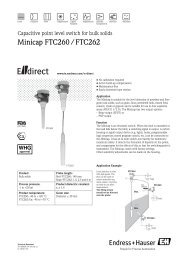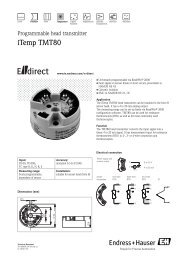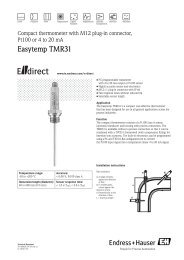The Liquiphant Family - Endress+Hauser Ireland
The Liquiphant Family - Endress+Hauser Ireland
The Liquiphant Family - Endress+Hauser Ireland
Create successful ePaper yourself
Turn your PDF publications into a flip-book with our unique Google optimized e-Paper software.
<strong>The</strong> <strong>Liquiphant</strong> <strong>Family</strong><br />
Level limit detection in liquids<br />
using the vibration principle
Convincing...<br />
Analysis electronics<br />
Detection of<br />
frequency shift<br />
<strong>The</strong> original and best<br />
When <strong>Endress+Hauser</strong> invented the vibration<br />
principle 20 years ago it paved the way<br />
to safe and reliable level monitoring. <strong>The</strong><br />
<strong>Liquiphant</strong> soon became a classic. More<br />
than 2 million measuring points worldwide<br />
emphasise <strong>Endress+Hauser</strong>’s competence in<br />
liquid media limit detection.<br />
Quality and safety are synonymous with<br />
<strong>Endress+Hauser</strong> instrumentation. <strong>The</strong> latest<br />
simulation and manufacturing procedures<br />
are used from development through to<br />
production in order to meet requirements.<br />
<strong>Endress+Hauser</strong> is a family-owned company<br />
with over 6,700 employees, serving<br />
customers in 37 countries worldwide. <strong>The</strong><br />
international solution provider has offered a<br />
large range of products and services for all<br />
process automation sectors for more than<br />
50 years.<br />
Functional principle<br />
Limit switches using the vibration principle<br />
are used in process automation applications<br />
everywhere. What is the reason for this<br />
success? Vibration limit switches operate<br />
safely and are technically so mature that they<br />
may be tailored exactly to user requirements.<br />
A sensor in form of a tuning fork is exited<br />
to its resonant frequency by a piezoelectric<br />
drive. <strong>The</strong> frequency changes as liquid<br />
covers the fork. This change is analysed<br />
and converted into a switching signal.<br />
<strong>The</strong> instruments of the <strong>Liquiphant</strong> family<br />
monitor level limits of all liquids in tanks,<br />
vessels and pipes. Applications are<br />
wideranging and cover simple operational level<br />
limit detection (minimum and maxi mum<br />
monitoring) and WHG 1 -certifi ed leakage<br />
monitoring or overspill protection through<br />
to protective facilities in plant parts subject<br />
to Disturbance Regulations.<br />
1<br />
WHG (Wasserhaushaltsgesetz) – German Water<br />
Preservation Act<br />
Resonant circle<br />
• Frequency<br />
shift upon<br />
immersion<br />
into the media<br />
• Associated<br />
mass increases<br />
Bimorph and stack drive –<br />
the heart of <strong>Liquiphant</strong><br />
A combination of<br />
mechanics and electronics<br />
(mechatronics) – tried and<br />
tested level limit detection<br />
Benefits:<br />
• <strong>Liquiphant</strong> – the instrument for all level<br />
limit applications<br />
• <strong>Endress+Hauser</strong> - your reliable process<br />
automation partner<br />
2
For universal use across the process<br />
industries<br />
A distinct advantage of the vibration principle<br />
is its mode of operation. Level limits are<br />
detected almost unaffected by the physical<br />
properties of the medium, e.g. conductivity,<br />
dielectric constant, viscosity, changes in<br />
density, pressure or temperature. In addition,<br />
turbulence, foam or bubbling liquids do not<br />
impair the operation either. <strong>The</strong>se unique<br />
performance features permit the instruments<br />
of the <strong>Liquiphant</strong> family to be employed in<br />
all process engineering sectors. <strong>The</strong> most<br />
important industries are:<br />
• Chemicals/petrochemicals<br />
• Pharmaceuticals<br />
• Food<br />
• Environment<br />
• Energy<br />
Vibration limit switches have no moving<br />
parts, therefore calibration in the medium<br />
is not required. In combination with<br />
integrated self-monitoring, this technology<br />
has prevailed in process automation because<br />
of its reliability.<br />
Due to its universal nature, <strong>Liquiphant</strong><br />
has proved itself in millions of applications<br />
worldwide.<br />
Universal applications and<br />
no calibration required in<br />
changing liquids<br />
Unaffected by turbulence<br />
and external vibration<br />
Universal applications<br />
in air bubbles and foam<br />
(foam is not recognised<br />
as liquid)<br />
Universal applications<br />
in all pumpable liquids<br />
up to a viscosity of<br />
10,000 cSt (mm 2 /s)<br />
Benefits:<br />
• Fast commissioning – no calibration<br />
necessary<br />
• Using one type of instrument in different<br />
applications reduces logistics expenditure<br />
3
Safe…<br />
Numerous connections<br />
Hygienic and easily adapted process<br />
connections meet the requirements of the<br />
food industry. Numerous standards have<br />
been established in practical operation.<br />
<strong>Liquiphant</strong> M FTL50H/FTL51H offers a<br />
large selection of common connections,<br />
e.g. dairy fi tting, Varivent, DRD, TriClamp,<br />
NEUMO etc. thus safeguarding the<br />
adaptation to these standards.<br />
3.1.B certified materials<br />
Process safety and traceability are constantly<br />
gaining more importance in the food industry.<br />
Where requested, <strong>Endress+Hauser</strong> uses<br />
certifi ed materials for parts in contact with<br />
media, e.g. sensor and welded accessories.<br />
An EN 10204 material certifi cate is included<br />
in the scope of delivery and welded<br />
accessories are supplied with FDA-listed<br />
sealing material.<br />
Hygienic design<br />
Process conditions in the food industry place<br />
high demands on level limit instruments.<br />
<strong>The</strong>se requirements are met by the hygienic<br />
version of <strong>Liquiphant</strong> M with its polished<br />
sensor (R a ≤1.5 µm or R a ≤ 0.3 µm), the<br />
relevant connections and the stainless steel<br />
housing. This housing has a lasered type<br />
plate (which cannot be lost) and is thus<br />
ideally suited to high-pressure external<br />
cleaning.<br />
<strong>Liquiphant</strong> M is FDA, EHEDG and 3A<br />
certifi ed.<br />
<strong>The</strong> modular instrument concept with its<br />
exchangeable components and electronic<br />
interfaces facilitate easy and fl exible<br />
adap tation to existing systems at any time.<br />
Standard <strong>Liquiphant</strong><br />
M FTL50H/FTL51H<br />
includes a large selection<br />
of hygienic process<br />
connections<br />
Minimum alarm<br />
<strong>Liquiphant</strong> M in the wet<br />
area of a food plant<br />
Benefits:<br />
• Experience a simplifi ed plant<br />
validation with tested and certifi ed<br />
instruments<br />
• <strong>The</strong> instruments adapt to your plant and<br />
not vice versa<br />
4
External cleaning<br />
<strong>The</strong> stainless steel housing provides resistance<br />
against aggressive cleaning agents. It also<br />
offers hygienic advantages, as it has no<br />
dead space, is condensation resistant and is<br />
easily cleaned. <strong>The</strong> <strong>Liquiphant</strong> M standard<br />
design includes IP 66 ingress protection.<br />
<strong>The</strong> installed Goretex fi lter reliably prevents<br />
condensate formation inside the housing.<br />
In addition, the O-ring integrated at the<br />
edge of the electronic insert seals the<br />
inner part of the sensor against the interior<br />
space of the housing. <strong>The</strong> sealing concept<br />
has proved its worth and offers a high<br />
degree of operational safety in all hygienic<br />
applications in which chemical agents<br />
and cleaning devices are used for external<br />
cleaning.<br />
Dry-run protection<br />
All models of the <strong>Liquiphant</strong> family (with<br />
the exception of <strong>Liquiphant</strong> S Failsafe<br />
FDL60/61) may also be used as minimum<br />
limit switches, e.g. in pipes from a nominal<br />
diameter of DN 25 onwards. A setting<br />
at the electronic insert (minimum safety)<br />
ensures the reliable operation of the<br />
instru ments. For example, when used in<br />
dry-run protection of pumps. In addition,<br />
special sensor properties support the safe<br />
and reliable operation since the sensor is<br />
unaffected by air bubbles, foam formation or<br />
pipe vibration.<br />
<strong>Liquiphant</strong> stainless steel<br />
housing with strong<br />
condensation formation<br />
Construction without<br />
seals and gapless to fit<br />
perfectly in hygienic<br />
applications<br />
<strong>Liquiphant</strong> T FTL20 in<br />
minimum detection and<br />
pump cut-off<br />
Reliable protective<br />
measures inside the<br />
instrument<br />
Benefits:<br />
• Clean your plant as usal without any<br />
additional effort<br />
• Maximum or minimum monitoring – one<br />
instrument type for all measurement tasks<br />
5
Safe…<br />
Ignition risk protection<br />
Safe instrumentation – even in case of an<br />
error, <strong>Liquiphant</strong> must not be the cause<br />
of any ignition risk. <strong>Endress+Hauser</strong> took<br />
this into consideration during the<br />
develop ment stage, ensuring that sparks<br />
cannot occur during the exchange of<br />
electronics in an Ex zone, despite open<br />
contacts.<br />
For this reason, Ex zone instruments have an<br />
integrated Zener barrier. <strong>Liquiphant</strong> thus<br />
offers a high degree of safety also in relation<br />
to the service concept.<br />
Antistatic coating<br />
Different sensor materials are often used in<br />
chemical processes or in mixed substances<br />
(Explosion Group IIB/IIC). Coating is<br />
applied where stainless steel is not suffi cient<br />
to protect instruments against corrosion.<br />
<strong>The</strong> operator is responsible for excluding<br />
electrostatic charging in vessels. Coating<br />
media-contacting parts with a conductible<br />
surface (PFA) reliably prevents electrostatic<br />
charging of the sensor.<br />
<strong>The</strong>refore, <strong>Liquiphant</strong> is not subject to any<br />
limitations in relation to the operation of<br />
systems with plastic coating in Zone 0/1<br />
(ATEX II 1/2G).<br />
Benefits:<br />
• Fast and safe commissioning of the<br />
instrument as well as exchange of<br />
electronics on site in Ex zones<br />
• One type of instrument in different<br />
applications reduces your logistics<br />
expenditure and increases safety<br />
ATEX<br />
6
Second line of defence<br />
Is it possible to further increase the standard<br />
safety of a <strong>Liquiphant</strong> in order to reduce<br />
the risk of damage to a plant? Yes!<br />
<strong>The</strong> instruments may be equipped with a<br />
second mechanical process se pa ration –<br />
second line of defence. A process<br />
connec tion, usually a thread or fl ange, adapts<br />
the instruments to the existing vessel or<br />
pipe. This mechanical connection separates<br />
the process atmosphere (temperature,<br />
pressure, aggressiveness, toxicity) from<br />
its external environment. <strong>The</strong> fi rst barrier<br />
for the medium results from welding the<br />
process connection to the parts of the<br />
instrument located in the process.<br />
While the fork of a <strong>Liquiphant</strong> is monitored<br />
for corrosion, passive components, e.g. pipe<br />
extensions, cannot recognise such errors.<br />
<strong>The</strong> medium might be forced outside if, for<br />
example, pitting corrosion occurs in a pipe<br />
extension. <strong>The</strong> second barrier of a pressure,<br />
gas or diffusion-tight feedthrough – second<br />
line of defence – prevents this in a safe and<br />
reliable manner.<br />
In <strong>Liquiphant</strong>, this second process separation<br />
is a glass seal set in metal. It ensures the<br />
electric connection to the fork drive and is<br />
provided pressure-proof (O-ring) or even<br />
diffusion-proof (welded) behind the process<br />
connection.<br />
<strong>Liquiphant</strong> M offers the second process<br />
separation as an option – in <strong>Liquiphant</strong> S<br />
FTL70 and FTL71 it is part of the standard<br />
scope of delivery.<br />
<strong>Liquiphant</strong> S –<br />
welded feedthrough<br />
<strong>Liquiphant</strong> M –<br />
O-ring-sealed<br />
feedthrough<br />
Benefit:<br />
• Extend the basic safety of a <strong>Liquiphant</strong>, if<br />
your application requires it<br />
7
Innovative…<br />
Extended process temperatures<br />
Level limit measurements in process<br />
temperatures up to +280 °C (+300 °C<br />
for maximum 40 hours) do not present<br />
any problem for <strong>Liquiphant</strong> S (High<br />
Temperature) FTL70/FTL71! Make use of<br />
the advantages of a vibration limit switch<br />
even in extreme process conditions.<br />
<strong>The</strong> requirements of instrument material<br />
and development rise drastically in the<br />
process temperature range above 200 °C.<br />
Extreme requirements can only be rea lised<br />
by the careful selection of suitable materials,<br />
the latest technologies and strain simulations.<br />
Process and environmental safety are of<br />
paramount importance. <strong>Liquiphant</strong> S (High<br />
Temperature) takes all requirements into<br />
consideration in its special design, safety<br />
and certifi cation concept.<br />
Design<br />
• Electrical connector for every process<br />
control<br />
• Threads starting at G ¾", fl anges starting<br />
at DN 25<br />
• Different materials for all parts in contact<br />
with media:<br />
Stainless steel 1.4435/1.4462 or Alloy C<br />
PFA Plastics (up to 230 °C)<br />
Enamel (up to 200 °C)<br />
Safety<br />
• Materials geared to each other for the<br />
entire temperature range, including<br />
extreme temperature fl uctuations<br />
• Integrated, gas-tight process feedthrough<br />
(welded) is standard<br />
• Automatic corrosion recognition<br />
• 3.1.B materials and certifi cates as<br />
standard<br />
Approvals<br />
• Overspill protection WHG checked at the<br />
push of a button<br />
• SIL 2/3 according to IEC 61508 and<br />
61511<br />
• ATEX II EEx ia, EEx de, EEx d<br />
• CSA<br />
• FM<br />
Fissures in V4A<br />
(conventional instruments)<br />
Stability in Duplex-steel<br />
(<strong>Liquiphant</strong> S HT)<br />
Stack drive – materials<br />
geared to each other<br />
Benefits:<br />
• You only use instruments geared to your<br />
process<br />
• High degree of reliability and long<br />
serviceable life – even in extreme process<br />
conditions<br />
8
<strong>Liquiphant</strong> S FTL71 in<br />
minimum detection in a<br />
jacketed vessel<br />
<strong>Liquiphant</strong> S FTL71 in<br />
maximum detection<br />
Two <strong>Liquiphant</strong> S FTL71<br />
instruments in a bitumen<br />
loading point<br />
User-friendly and application-oriented<br />
<strong>The</strong> signifi cantly extended application limits<br />
and the tried and tested advan tages of the<br />
vibration principle mean <strong>Liquiphant</strong> S (High<br />
Temperature) works hard. A few typical<br />
applications for <strong>Liquiphant</strong> S FTL70 and<br />
FTL71 are listed below.<br />
• Vessels with chemical processes at<br />
temperatures above +150 °C – for e.g.<br />
secondary amine pro ducts in an agitated<br />
tank. Density changes of different products<br />
do not affect the switching properties of<br />
the sensor.<br />
• High-temperature heating systems –<br />
thermal oil in buffer tanks.<br />
• Textile fibre melting – polyethylene,<br />
nylon processing.<br />
• Insulated tanks in steam applications –<br />
water expansion vessels (63 bar steam<br />
pressure corresponding to +278 °C).<br />
• Media reaching minimum viscosity only<br />
at high temperatures – processing of<br />
resins, bitumen or sulphur.<br />
• All applications in which mechanical<br />
systems need frequent cleaning or<br />
corrosion checks.<br />
Benefit:<br />
• You use instruments which have been<br />
tried and tested in operation<br />
9
Innovative…<br />
Standardised self-monitoring<br />
Compared to other physical measuring<br />
principles, e.g. conductive probes or fl oat<br />
switches, <strong>Liquiphant</strong> offer a real advantage –<br />
frequency evaluation facilitating automatic<br />
self-monitoring of the fork. A change in<br />
oscillation surpassing a permitted variable<br />
indicates irregularities of the fork, e.g.<br />
corrosion or build-up. This automatically<br />
triggers safety-oriented switching in the<br />
instrument. All versions of <strong>Liquiphant</strong><br />
work with such a frequency evaluation and<br />
offer the user safe plant operation in their<br />
standard design.<br />
Intelligent sensor without calibration<br />
Every fork has its own characteristic<br />
frequencies. <strong>The</strong>se specifi c parameters must<br />
be available, if needed, during the entire<br />
period of operation. Intelligent, electronic<br />
components that are fi rmly connected to<br />
the fork safeguard the availability of these<br />
parameters at any time.<br />
How it is done<br />
When changing electronics, the new<br />
electronic insert is automatically uploaded<br />
with the fork parameters. <strong>The</strong> instrument<br />
calibrates itself and can be used immediately<br />
after the exchange. Time-consuming,<br />
manual instrument calibration, e.g. by<br />
potentiometer, is not required.<br />
fa 15 % Switch point at approx. 850 Hz<br />
fa Oscillation in air approx. 1 kHz<br />
Immersion depth [mm]<br />
25<br />
A<br />
L<br />
A<br />
R<br />
M<br />
A<br />
L<br />
A<br />
R<br />
M<br />
Frequency change caused<br />
by build-up (low alarm)<br />
0<br />
0 400 fa 15 % fa fa +6,5 % 1500 f [Hz]<br />
Sensor alarm Normal operation Corrosion alarm Sensor alarm<br />
Frequency evaluation<br />
Frequency change caused<br />
by corrosion (high alarm)<br />
Benefits:<br />
• Safety-oriented switching without<br />
any calibration, even if errors occur<br />
• Irrespective of which <strong>Liquiphant</strong> you<br />
employ, frequency evaluation and<br />
selfmonitoring are always integrated<br />
10
Intrinsically safe signal<br />
transmission<br />
NAMUR<br />
EN 50227/DIN 19234<br />
8/16 mA<br />
PulseFrequencyModulation<br />
Current pulse<br />
FEL 58<br />
2,1 mA<br />
1,2 mA 1,2 mA<br />
FEL 55<br />
16 mA<br />
8 mA 3,6 mA<br />
FEL 57<br />
150 Hz 50 Hz 0 Hz<br />
uncovered<br />
covered sensor defect<br />
uncovered<br />
covered sensor defect<br />
uncovered<br />
covered sensor defect<br />
To be connected to<br />
Sensor defect (corrosion)<br />
• NAMUR breaker amplifier<br />
e.g. E+H FTL325N, FTL375N<br />
• Remote I/O<br />
• Analogue I/O e.g. SPS<br />
• 4... 20 mA MUS e.g. RMA 422<br />
• <strong>Endress+Hauser</strong> Nivotester<br />
FTL32x(P) und FTL37x(P)<br />
Line breakage/<br />
short circuit<br />
Functional safety SIL<br />
IEC 61508 and 61511<br />
Separate fault message relay<br />
(Fault = Level)<br />
(Fault ≠ Level)<br />
Test function “Periodical<br />
inspection”<br />
Undefined status (load)<br />
Max. detection<br />
3-channel transmitter PFM/NAMUR<br />
Reducing wiring expenditure and optimising<br />
use of control cabinets means lower costs –<br />
<strong>Endress+Hauser</strong>’s instrumentation sets a<br />
good example! Nivotester FTL325 and<br />
FTL375 transmitters are available in 3-channel<br />
version for NAMUR and PFM technology<br />
and in top-hat rail and 19" versions. This<br />
permits plants (in Ex zones) to be designed<br />
in an cost-effective manner.<br />
How it is done<br />
Providing on-off control and an overspill<br />
protection in one vessel with only one<br />
transmitter has proven itself to be an<br />
important advantage in practical operation.<br />
<strong>The</strong> required cabinet space is significantly<br />
reduced, if 30 measuring points use only<br />
10 transmitters instead of 30 power supply /<br />
switching units.<br />
FTL375P/N<br />
FTL325P/N<br />
Benefits:<br />
• Optimum use of your time in installation<br />
and maintenance<br />
• Plan and realise your plant in a<br />
cost-effective manner<br />
11
Cost-effective…<br />
Segmentation<br />
“You only pay what you really need.”<br />
<strong>Endress+Hauser</strong> takes this statement seriously<br />
and offers instrument types in three different<br />
segments.<br />
All <strong>Liquiphant</strong> limit switches are characterised<br />
by a high quality standard. <strong>The</strong> instruments<br />
have been designed in a modular fashion<br />
in the M and S segment, allowing users<br />
to select an instrument tailored to their<br />
application.<br />
Part of the variety of the modular instrument<br />
design is:<br />
• Different lenghts<br />
• All process connections<br />
• A variety of electronic interfaces<br />
• Different sensor materials<br />
• Approvals and certificates for all areas<br />
• Special designs<br />
Technical details can be found on page 16.<br />
FTL50H<br />
FDL60<br />
FTL70<br />
FTL50<br />
FTL50H<br />
FTL51C<br />
FTL20<br />
FTL20H<br />
S – segment<br />
For demanding applications e.g. high process<br />
temperatures or as part of an overspill<br />
protection eliminating annual function<br />
inspection.<br />
Important industries of the S segment:<br />
• Petrochemicals<br />
• Oil & Gas<br />
M – segment<br />
Applications combining the respective<br />
instrument variants in one modular system.<br />
Important industries of the M segment:<br />
• Chemicals<br />
• Food<br />
• Pharmaceuticals<br />
T – segment<br />
• Simple selection<br />
• Instrument exchange in case of defect<br />
• Fast delivery<br />
• Focus on factory automation and food<br />
applications<br />
Benefits:<br />
• Only pay for what you need<br />
• Instrumentation is optimised for the<br />
application<br />
12
Overspill protection<br />
High demands are placed on overspill<br />
protection in process engineering. <strong>The</strong><br />
<strong>Liquiphant</strong> complies with all current<br />
European legislation and can even be used<br />
as part of a safety instrumented system in<br />
accordance with IEC 61508/IEC 61511.<br />
IEC 61508/61511 aims to provide a uniform<br />
approach to risk assessment. It aims to defi ne<br />
the tolerable risk, establish the current risk<br />
and specify the risk reduction required to<br />
achieve a given safety integrity level (SIL).<br />
IEC 61511 is aimed specifi cally at the process<br />
industry.<br />
<strong>Liquiphant</strong> M & S used in conjunction with<br />
the Nivotester switch unit, based on the<br />
PMF technology, have been designed and<br />
manufactured to meet the requirements of<br />
IEC 61508. <strong>The</strong>y have been certifi ed by<br />
the German TÜV as suitable for inclusion in<br />
safety instrumented systems in accordance<br />
with the above standards. A safety manual<br />
is available detailing all relevant data needed<br />
to complete safety system calculations.<br />
Probability of failure on demand (PFD),<br />
hardware fault tolerance (HFT) and safe<br />
failure fraction (SFF) fi gures return values<br />
that typically fall within the required<br />
suitability range for SIL 2/3.<br />
Additionally, an integral function check<br />
facility allows remote system testing<br />
without removing the probe from the tank.<br />
Regular function tests can be carried out<br />
safely and cost-effectively at the mere press<br />
of a button!<br />
Benefits:<br />
• You work with a competent partner in all<br />
issues of safety engineering<br />
• Products which fit into your national<br />
legislation<br />
13
Cost-effective…<br />
Functional safety<br />
<strong>The</strong> process industry demands the highest<br />
degree of safety and reliability from<br />
components of distributed control systems<br />
(DCS). <strong>Endress+Hauser</strong>’s instrumentation<br />
meets these requirements of functional safety<br />
and is at home in all processes relevant to<br />
safety. <strong>The</strong> required level of safety of a<br />
technical plant is classifi ed according to the<br />
international IEC 61511 standard and is<br />
determined using risk assessment. <strong>The</strong><br />
international standard for functional safety,<br />
IEC 61508, describes the guideline for<br />
safety instrumented systems in order to<br />
reduce the risks to people, assets and the<br />
environment. A compliant loop normally<br />
consists of a measuring instrument, a<br />
control unit and an actor. Both standards<br />
subdivide plants and instruments into four<br />
safety levels: from SIL 1 for low risks<br />
through to SIL 4 for very high risks.<br />
<strong>The</strong> <strong>Liquiphant</strong> M, <strong>Liquiphant</strong> S and<br />
<strong>Liquiphant</strong> S Failsafe in conjunction with the<br />
Nivotester switch units, have been designed<br />
in accordance with IEC 61508 and meet<br />
the requirements of the standard. A safety<br />
document is available which provided the<br />
data required to allow the <strong>Liquiphant</strong> to<br />
be included as part of the risk assessment<br />
calculations. Test periods are also defi ned<br />
and use the standard function test facility<br />
as a means of confi rming the system<br />
functionality.<br />
<strong>Liquiphant</strong> M – FTL50/51, FTL51C with<br />
plastic or enamel coating up to +150 °C.<br />
<strong>Liquiphant</strong> S – FTL70/71 up to +280 °C,<br />
with PFA coating up to +230 °C,<br />
with enamel coating up to +200 °C.<br />
SIL 2<br />
SIL 3<br />
PFM<br />
PFM<br />
FEL51, 2-wire AC<br />
FEL52, 3-wire DC-PNP<br />
FEL54, AC/DC DPDT<br />
FEL55, 8/16 mA<br />
<strong>Liquiphant</strong> M FTL50/51/51C<br />
<strong>Liquiphant</strong> S FTL70/71<br />
Periodical inspection by start or<br />
disassembly<br />
<strong>Liquiphant</strong> M FT50/51/51C<br />
<strong>Liquiphant</strong> S FTL70/71<br />
Periodical inspection by pressing a button<br />
(function test)<br />
NAMUR<br />
<strong>Liquiphant</strong> S Failsafe FDL60/61<br />
Periodical inspection may be waived<br />
PFM<br />
<strong>Liquiphant</strong> M FTL50/51/51C<br />
<strong>Liquiphant</strong> S FTL70/71<br />
Periodical inspection by start or disassembly<br />
<strong>Liquiphant</strong> M FTL50/51/51C<br />
<strong>Liquiphant</strong> S FTL70/71<br />
Periodical inspection by pressing a button<br />
(function test)<br />
Benefits:<br />
• Reduce the time for developing<br />
operational proof<br />
• Economical operation of one type of<br />
instrument in safety applcations<br />
14
Instrumentation via fieldbus<br />
Fieldbus technology has conquered large<br />
areas of process engineering and automation<br />
technology is unthinkable without it today.<br />
Modern plants are increasingly realised in<br />
fi eldbus techno logy.<br />
<strong>Endress+Hauser</strong> is the fi rst producer of<br />
instrumentation to equip vibration limit<br />
switches with fi eldbus interfaces. <strong>The</strong>se<br />
instruments can be integrated into exis ting<br />
topologies safe for the future without any<br />
expenditure.<br />
PROFIBUS PA<br />
An increasing number of users employ<br />
<strong>Liquiphant</strong> M and <strong>Liquiphant</strong> S with<br />
PROFIBUS PA electronics. Further<br />
information concerning the sensor, e.g. the<br />
current oscillation, may be read out via<br />
PROFIBUS PA. In addition, it is possible to set<br />
different sensor parameters via operating<br />
software (e.g. Fieldcare from<br />
<strong>Endress+Hauser</strong>). Profi t from our<br />
ex perience and our know-how from more<br />
than 30,000 instruments installed.<br />
AS-Interface<br />
<strong>Liquiphant</strong> T FTL20 is the fi rst <strong>Liquiphant</strong><br />
with AS interface (ASi) electronics. ASi-bus<br />
is a simple network solution for actors and<br />
sensors. It has become a standard in plant<br />
automation.<br />
<strong>Liquiphant</strong> M FTL50<br />
used as a maximum<br />
alarm in a PROFIBUS PA<br />
plant<br />
<strong>Liquiphant</strong> T FTL20 used<br />
as empty detection in a<br />
DN 50 pipe, integrated<br />
into an ASi-bus network<br />
Benefit:<br />
• Fieldbus systems offer simple<br />
commissioning and the possibility of<br />
additional process information<br />
15
A complete programme of proven technology<br />
<strong>The</strong> <strong>Liquiphant</strong> family at a glance<br />
<strong>Liquiphant</strong> T<br />
<strong>Liquiphant</strong> S<br />
Description FTL20 FTL260 FTL20H FTL50<br />
FTL51<br />
Applications Standard Hygiene /<br />
Food<br />
FTL50H<br />
FTL51H<br />
Standard Hygiene /<br />
Pharma<br />
Design Compact Compact +<br />
Pipe extension<br />
Process<br />
temperature (°C)<br />
Process pressure<br />
max. (bar)<br />
Process<br />
connections<br />
Output<br />
Approvals<br />
Application limits<br />
G ½"<br />
G ¾"<br />
G 1"<br />
AC, DC, ASi<br />
bus<br />
WHG<br />
overspill<br />
WHG<br />
leakage<br />
FTL51C FTL70 FTL71 FDL60 FDL61<br />
Coating High temperature Failsafe<br />
Pipe<br />
extension<br />
Compact<br />
Pipe<br />
extension<br />
-40... +150 -50... +150 -60... +280<br />
(+300 / 50 h cum.)<br />
Compact<br />
-40... +150<br />
40 64 / 100 40 100 40<br />
G 1" G ½"<br />
G ¾"<br />
G 1" Hygiene<br />
AC, DC<br />
WHG<br />
overspill<br />
AC, DC,<br />
ASi bus<br />
WHG overspill<br />
EHEDG<br />
G ¾", G 1", flange DIN, ANSI, JIS, Hygiene<br />
G ¾", G 1", flange DIN,<br />
ANSI, JIS,<br />
AC, DC, AC-DC relay, NAMUR, 8/16 mA, PFM,<br />
PROFIBUS PA<br />
EHEDG, 3A<br />
WHG overspill, SIL 2 / 3, ATEX, CSA, FM<br />
Very viscous media (viscosity max. 10,000 cSt / mm 2 / s), bridge formation by hardening build-up<br />
Pipe<br />
extension<br />
G 1", flange DIN, ANSI, JIS,<br />
Hygiene<br />
PFM<br />
WHG overspill, SIL 3, ATEX,<br />
CSA, FM, VdTÜV 100<br />
(liquefied gas)<br />
Fruther documentation<br />
FA001F Level Measurement<br />
CP007F Selection Guide Level Limit Detection<br />
Applicator ® Selection Software<br />
Technical Information<br />
TD001E <strong>Liquiphant</strong> T FTL260<br />
TD019E <strong>Liquiphant</strong> T FTL20<br />
TI328F <strong>Liquiphant</strong> M FTL50/51/50H/51H<br />
TI347F <strong>Liquiphant</strong> M FTL51C<br />
TI223F <strong>Liquiphant</strong> S Failsafe FDL60/61<br />
TI354F <strong>Liquiphant</strong> S FTL70/71<br />
TI350F Nivotester FTL325P<br />
TI360F Nivotester FTL375P<br />
TI379F <strong>Liquiphant</strong> T FTL20H<br />
TD021E Nivotester FTL325N/375N<br />
Instruments International<br />
09.03/MMC<br />
<strong>Endress+Hauser</strong> GmbH+Co. KG<br />
Instruments International<br />
Colmarer Straße 6<br />
79576 Weil am Rhein<br />
Germany<br />
Tel. +49 7621 975 02<br />
Fax +49 7621 975 345<br />
http://www.endress.com<br />
info@ii.endress.com<br />
CP003F/00/en/10.06<br />
52023448<br />
UE/INDD 2.0


